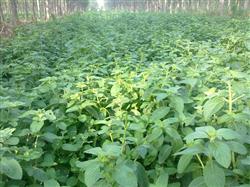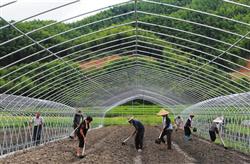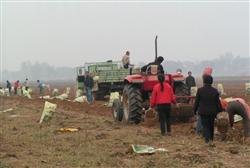How to manage the cultivation of peppermint?

How to manage the cultivation of peppermint? Please introduce the daily management methods for planting peppermint. The daily management mainly includes seedling replenishment, weeding, water and fertilizer management, heart picking and so on. The following operation methods are introduced in detail for reference: seedling replenishment in order to obtain high yield, seedling retention in the field must maintain a certain density. If the density is too high, the lower leaves of the branches are easy to fall off; if the density is too low, the basic seedlings are insufficient, and the yield is limited. Therefore, we must do a good job of density and thinning, generally leaving 25000 seedlings per mu in the first stubble and 50 000 seedlings in the second stubble after the first stubble of 10cm ~ 13cm. Four key points should be achieved: first, timely: the first stubble seedling height 12cm~15cm, when the plant shape is easy to distinguish; the underground rhizome has not yet grown, easy to dig clean; the seedling is small, the transplanting survival rate is high. Second, it depends on the sky: if the mud is wet on a cloudy day, you can dig through the roots to remove impurities. Third, it should be carefully identified from the aspects of plant shape, color, smell and so on. Fourth, repeat: check frequently, pull out as soon as you see miscellaneous things, and get rid of them until they are finished. The temperature of weeding in middle tillage is low in seedling stage, which is beneficial to the growth of weeds. We should grasp the sunny day and cut weeds 2 ~ 3 times in shallow ploughing before closing the row. As the mint rhizome into the soil shallow, near the root should be shallow hoe, the row can be a little deeper, can not hoe the underground rhizome. Through ploughing and weeding, it can reduce the consumption of soil water and nutrients, increase the soil temperature, improve the aeration condition and promote the growth of mint. Pull the grass again before harvest. After the first stubble mint harvest, use a hoe to hoe the border surface once, hoe off the remaining stubble and weeds, and thoroughly manage the ditch, cover the ditch mud on the border surface to facilitate the emergence and growth of the second crop mint. When the growth of stems and leaves of mint seedlings began to slow down, 500kg, or ternary compound fertilizer 10kg, was applied per mu to make the seedlings have sufficient nutrients and grow healthily. Before and after the branching fertilizer the Beginning of Summer, the air temperature increased, the growth rate accelerated, the photosynthesis was exuberant, the leaves increased and began to branch. When the seedlings were high 12cm~15cm, the branching fertilizer should be applied again, and the nitrogen, phosphorus and potassium fertilizer should be applied together. Generally, the high quality compound fertilizer 25kg should be used per mu, and the holes or ditches should be opened between rows before rain. Chemical fertilizer must be applied after the dew is dry or when there is no water on the leaves before rain, so as to prevent the fertilizer from touching the leaves and burning the leaves. At the same time, we should not apply nitrogen fertilizer alone to prevent the stems and leaves from growing too long, causing lodging in the later stage and affecting the yield. Leaf protection fertilizer at the beginning of June, the leaf gradually began to mature depends on the appearance, the appropriate amount of supplementary application of leaf protection fertilizer. If the growth is good, there is no need for supplementary application, and the appropriate amount of supplementary application with poor growth can also be applied by spraying fertilizer outside the root. Quick-acting fertilizer should be applied by 25d~30d before harvest, while long-acting fertilizer should be applied by 40d~45d before harvest. Early supplementary application in the later stage is easy to early senescence, too late supplementary application is easy to greedy green and late ripening, affecting the yield and quality. Water and fertilizer management peppermint rhizome and whisker root shallow into the soil, neither waterlogging nor drought tolerance. Mint land drainage is poor, often uneven emergence, after closing the row to before harvest, in case of continuous rain, extremely easy to get sick and defoliation, we must seriously do a good job in ditch drainage, so that the rain is dry, there is no stagnant water in the ditch. Sufficient water is needed during the growing period of stems and leaves. In case of drought and dry soil, horse race water is necessary. If the irrigation time is too long, it is easy to cause rotten roots and dead seedlings. The high temperature and drought from July to August will delay the emergence of the second crop mint and grow slowly. Timely watering is the key to the high yield of the second crop. In the summer noon, the temperature is too high, irrigation should be carried out in the morning and evening, to achieve rapid irrigation, rapid drainage is appropriate. Before harvest 20d~30d, irrigation should be stopped to make the soil dry properly, which is beneficial to the accumulation of nutrients, and can prevent plants from turning green and ripening delayed. The coring plant grows sparsely and the density is low. In May, the top is removed on a sunny day, and the top two layers of young leaves are removed, and a quick-acting chemical fertilizer or human and animal manure is applied once to promote the growth of new buds. It is forbidden to pick out the heart in dense plots. Click to get more mint planting technology click to get more medicine planting technology
- Prev

What should I pay attention to when growing peppermint?
What should I pay attention to when growing peppermint? Please give guidance to plant mint need to pay attention to the following points for reference: 1, garden selection and soil preparation and fertilization mint cultivation should choose land with fertile soil, flat terrain, good light, convenient transportation, combined with deep ploughing before sowing, apply high-quality farm manure 1500,200 per mu.
- Next

How to plant Rehmannia glutinosa?
How to plant Rehmannia glutinosa? There are netizens can help introduce planting methods Rehmannia glutinosa planting can refer to the following methods: first, Rehmannia glutinosa cultivation: to choose flat terrain, convenient drainage and irrigation, deep soil layer, loose soil, rich in organic matter, good water and fertilizer conservation is suitable for sandy loam, rotation period is ten.
Related
- Fuxing push coffee new agricultural production and marketing class: lack of small-scale processing plants
- Jujube rice field leisure farm deep ploughing Yilan for five years to create a space for organic food and play
- Nongyu Farm-A trial of organic papaya for brave women with advanced technology
- Four points for attention in the prevention and control of diseases and insect pests of edible fungi
- How to add nutrient solution to Edible Fungi
- Is there any good way to control edible fungus mites?
- Open Inoculation Technology of Edible Fungi
- Is there any clever way to use fertilizer for edible fungus in winter?
- What agents are used to kill the pathogens of edible fungi in the mushroom shed?
- Rapid drying of Edible Fungi

